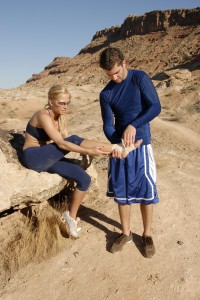So when it comes to a blog post about injuries we needed to call the experts in and fellow kiter Paul Barratt rose to the challenge.
Paul has worked in elite sports, with Manchester City FC and also in private practice. Currently he works within the National Health Service (NHS) in Greater Manchester, UK as an advanced practitioner. He has expert diagnostic skills and a wealth of experience in sports rehabilitation and injury prevention. Over to you Paul…
Bumps, bruises, strains and sprains, are the price we pay (and accept) for progression in kitesurfing on all too regular an occasion.
What we do following an injury I expect varies greatly. The R.I.C.E. or P.R.I.C.E. principle may be familiar to some. Others may reach for medication of many varieties such as ibuprofen or paracetamol (acetaminophen). Others may take medication left over from a previous injury such as co-codamol/zapain.
Massage (may increase bleeding and swelling)
**Please note medication can be dangerous if taken inappropriately so consult your local doctor (GP) to ensure medications are suitable for you before taking them.**
I hope that this will help in the event of injury but note that this is no replacement for seeking medical advice. If there is a lack of improvement or concern regarding the severity of the injury seek appropriate medical help.
Stay safe out there but make sure to have fun too!
[Remember before you try anything, take a look at our in depth instructional videos for your next trick or technique via our Player app – knowing how to land it will give you a better chance of staying injury free!]
References:
ICSI (2006) Health care guideline: ankle sprain. Institute for Clinical Systems Improvement.
Mason, L., Moore, R.A., Edwards, J.E. et al. (2004) Topical NSAIDs for acute pain: a meta-analysis.BMC Family Practice 5(1), 10.
NZGG (2003) The diagnosis and management of soft tissue knee injuries: internal derangements. Best practice evidence-based guideline. New Zealand Guidelines Group.
Jarvinen, T.A., Kaariainen, M., Jarvinen, M. and Kalimo, H. (2000) Muscle strain injuries. Current Opinion in Rheumatology 12(2), 155-161.


